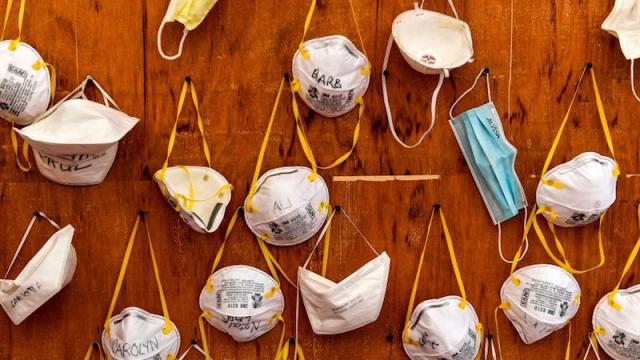A group of scientists will publish an open letter to the World Health Organisation (WHO) in the coming days with an alarming claim: The novel coronavirus is airborne, meaning that it can linger in the air long enough and in enough quantity to infect others.
[referenced url=”https://gizmodo.com.au/2020/07/my-friend-died-from-this-how-can-you-take-this-so-lightly/” thumb=”https://gizmodo.com.au/wp-content/uploads/2020/07/03/ytob6wxyip9inlykmetf-300×169.png” title=”My Friend Died From This. How Can You Take This So Lightly?” excerpt=”Are you a frontline worker dealing with new stresses or irresponsible management? Is working (or not working) from home starting to take a psychological toll? How are you coping with reopening? Submit a story using this Google form or send me an email with the subject line “My Covid Story” and…”]
The letter, which was reported by the Los Angeles Times and the New York Times, will also allegedly accuse the WHO of failing to issue appropriate warnings about the risk of contracting coronavirus via airborne transmission. The scientists are calling on the United Nations health agency to revise its recommendations and plan to publish their letter in Clinical Infectious Diseases.
The letter has been signed by 239 researchers from 32 countries and include experts in virology, aerosol physics, flow dynamics, exposure and epidemiology, medicine, and building engineering, according to a press release from the Queensland University of Technology.
Currently, the WHO and the Centres for Disease Control and Prevention (CDC) only warn about transmission from inhaling small droplets produced when infected people cough, sneeze or speak, or from touching a contaminated surface and then touching your eyes, nose or mouth. In interim guidance on infection prevention and control published on June 29, the WHO contends that airborne transmission can occur when health care workers perform medical procedures that produce aerosols, which are extremely small respiratory droplets.
The CDC, meanwhile, has stated that the coronavirus touching infected surfaces is not the primary way the virus spreads.
Nonetheless, per the Los Angles Times, the experts argue that this guidance that warns about the two types of transmission ignores the evidence that airborne transmission also plays a significant role in the virus’s spread.
In the letter, the scientists purportedly highlight multiple studies that they say demonstrate that aerosols can hang in the air for long periods of time and float dozens of feet. This makes poorly ventilated rooms, buses, and other confined spaces dangerous, even if people keep the recommended six feet of distance from one another.
“We are 100 per cent sure about this,” Lidia Morawska, one of the letter’s authors, told the Los Angeles Times.
[referenced url=”https://gizmodo.com.au/2020/07/rapid-antibody-testing-wont-reliably-tell-you-if-youve-had-coronavirus-review-finds/” thumb=”https://gizmodo.com.au/wp-content/uploads/2020/07/02/qqjgiqzfrhqc1uxtndwl-300×169.jpg” title=”Rapid Antibody Testing Won’t Reliably Tell You If You’ve Had Coronavirus, Review Finds” excerpt=”A new review out Wednesday paints a sorry picture about the state of antibody tests meant to find out whether you’ve ever had covid-19. It suggests that these tests range wildly in accuracy from manufacturer to manufacturer, with tests that quickly return results at the doctor’s office faring so badly…”]
Morawska is a professor of atmospheric sciences, environmental engineering, and environmental science and management at Queensland University of Technology in Brisbane, Australia.
“Numerous health authorities currently focus on hand washing, maintaining social distancing, and droplet precautions,” Morawska said in the press release. “Hand washing and social distancing are appropriate, but it is view, insufficient to provide protection from virus-carrying respiratory microdroplets released into the air by infected people.”
Experts that spoke to the Los Angeles Times said that airborne transmission appears to be the only way to explain several “super spreading” events, including the infection of people at a restaurant in China who sat at separate tables and choir members in Washington state who took precautions, such as using hand sanitizer and not hugging or shaking hands, during rehearsal. Of the 61 people at the choir rehearsal, 53 became sick and two died.
The WHO told the Los Angeles Times that the 239 researchers had based their assertions on lab experiments instead of field evidence. Dr. Benedetta Allegranzi, a WHO expert on infection prevention, said that a large majority of the group of more than 30 international experts advising the UN agency has “not judged the existing evidence sufficiently convincing to consider airborne transmission as having an important role in COVID-19 spread.”
Allegranzi said that airborne transmission “would have resulted in many more cases and even more rapid spread of the virus.”
Morawska said that measures to mitigate airborne transmission include providing sufficient and effective ventilation, such as supplying clean outdoor air and minimising recirculated air, particularly in public buildings, workplaces, schools, hospitals, and aged care homes. Another measure is supplementing general ventilation with infection controls, including local exhaust, high efficiency air filtration, and germicidal ultraviolet lights.
In addition, Morawska also noted a measure we’re all pretty familiar with by now: Avoid overcrowding, especially in public transport and buildings.
“These are practical and can be easily implemented and many are not costly. For example, simple steps such as opening both doors and windows can dramatically increase air flow rates in many buildings,” Morawska said.
José Jiménez, a chemistry and biochemistry professor at the University of Colorado at Boulder, told the Los Angeles Times that the idea of airborne transmission should not frighten people.
[referenced url=”https://gizmodo.com.au/2020/07/27000-coronavirus-linked-deaths-have-gone-uncounted-in-u-s-study-estimates/” thumb=”https://gizmodo.com.au/wp-content/uploads/2020/07/02/ojwxhauqquug978oj8yw-300×169.jpg” title=”27,000 Coronavirus-Linked Deaths Have Gone Uncounted in U.S., Study Estimates” excerpt=”It will take a long time to truly know the toll of deaths and injuries caused by the ongoing covid-19 pandemic. But a new study out Wednesday provides an early estimate of the excess deaths linked to the viral disease in the United States. It suggests that the country’s official…”]
“It’s not like the virus has changed,” Jiménez said. “We think the virus has been transmitted this way all along, and knowing about it helps protect us.”
[The Los Angeles Times and the New York Times]
Editor’s Note: Release dates within this article are based in the U.S., but will be updated with local Australian dates as soon as we know more.
